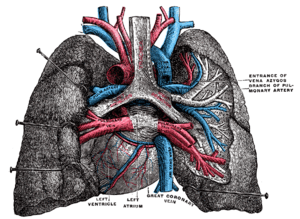Pulmonary vein stenosis
Pulmonary vein stenosis is a rare cardiovascular disorder. It is recognized as being the stenosis of one or more of the four pulmonary veins that return blood from the lungs to the left atrium of the heart. In congenital cases, it is associated with poor prognosis and high mortality rate. In some people, pulmonary vein stenosis occurs after pulmonary vein ablation for the treatment of atrial fibrillation.[1] Some recent research has indicated that it may be genetically linked in congenital cases.[2][3]
| Pulmonary vein stenosis | |
|---|---|
 | |
| Pulmonary veins | |
| Specialty | Cardiovascular |
References
- Latson, Larry; Prieto, Lourdes. "Congenital and Acquired Pulmonary Vein Stenosis". Circulation. American Heart Association. Retrieved 3 November 2014.
- Chen, Ming (April 1, 2014). "Clinical and Genetic Features of Pulmonary Vein Stenosis". Journal of the American College of Cardiology. 63 (12): A524. doi:10.1016/S0735-1097(14)60524-6. Retrieved November 2, 2014.
- Laar, Ingrid (July 4, 2009). "First locus for primary pulmonary vein stenosis maps to chromosome 2q". European Heart Journal. 30 (20): 2485–92. doi:10.1093/eurheartj/ehp271. PMID 19578166. Retrieved November 2, 2014.
This article is issued from
Wikipedia.
The text is licensed under Creative
Commons - Attribution - Sharealike.
Additional terms may apply for the media files.